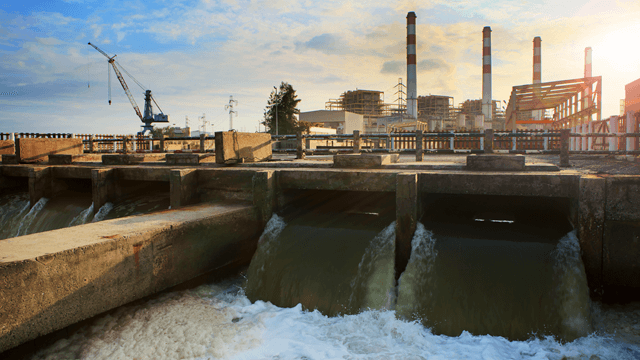Industrial Waste Water Treatment-- Efficient Waste Management for Manufacturing Facilities
Wiki Article
Secret Techniques in Industrial Waste Water Treatment Processes
The therapy of industrial wastewater is a crucial element of ecological monitoring, involving an array of techniques developed to alleviate the effect of impurities. Improvements in modern technologies such as membrane layer filtration and advanced oxidation processes provide innovative options for improving treatment efficiency.Physical Treatment Approaches
How efficiently can physical therapy approaches resolve the intricacies of industrial wastewater? Physical therapy approaches play a crucial duty in the initial phases of wastewater administration, concentrating mostly on the elimination of solids and big particulates. Techniques such as sedimentation, flotation, and purification are vital for lowering the focus of suspended solids, therefore enhancing the performance of subsequent treatment processes.Sedimentation entails the gravitational settling of solids, enabling for the splitting up of heavier products from the wastewater. This technique is particularly efficient in clarifying water prior to chemical or organic treatments.
Furthermore, flotation protection approaches, which use air bubbles to lift suspended solids to the surface for elimination, work in dealing with wastewater with high focus of fats, oils, and greases. On the whole, physical therapy techniques work as an important initial step in the extensive monitoring of commercial wastewater, making sure that the lots on subsequent treatment phases is reduced and boosting overall treatment efficiency.
Chemical Therapy Strategies
While physical treatment methods lay the groundwork for effective wastewater monitoring, chemical treatment techniques are essential for resolving the extra complicated contaminants commonly found in industrial effluents. These methods make use of various chemical representatives to precipitate, reduce the effects of, or oxidize damaging materials, making sure an extra complete elimination of pollutants.
One usual approach is coagulation and flocculation, where chemical coagulants such as light weight aluminum sulfate or ferric chloride are included in promote the gathering of suspended bits. This procedure enhances solid-liquid separation, lowering turbidity and improving water top quality. Additionally, neutralization processes are utilized to adjust the pH of wastewater, utilizing bases or acids to neutralize acidic or alkaline streams, respectively.
Oxidation-reduction reactions play a crucial function in derogatory organic pollutants and pathogens. Chemical oxidants like ozone, chlorine, or hydrogen peroxide are used to damage down complex organic substances, making them much less unsafe or extra biodegradable. Advanced oxidation processes (AOPs) integrate numerous oxidation techniques to improve contaminant removal effectiveness.
Biological Treatment Processes
The efficiency of wastewater treatment is substantially enhanced by biological therapy processes, which harness the natural metabolic activities of microorganisms to decay natural issue and remove pollutants. Industrial Waste Water Treatment. These processes largely entail cardiovascular and anaerobic digestion, each tailored for particular kinds of wastewaterAerobic treatment procedures utilize oxygen to sustain microbial growth, promoting the break down of natural pollutants right into co2 and water. Common approaches include triggered sludge systems, where aeration storage tanks promote the mixing of wastewater with microorganisms, and dripping filters, which encourage biofilm advancement on media surface areas.
Alternatively, anaerobic treatment processes happen in the absence of oxygen, using anaerobic microorganisms to disintegrate natural matter, leading to biogas manufacturing, a renewable energy resource. Anaerobic digesters are commonly used in industrial settings for this objective, efficiently reducing the quantity of sludge while creating useful biogas.
The choice of an organic treatment method relies on wastewater attributes, treatment goals, and governing requirements. The integration of organic processes in wastewater therapy not just boosts toxin removal effectiveness yet also advertises sustainability by decreasing chemical usage and supporting resource recovery.
Advanced Oxidation Processes

Usual AOP techniques include Fenton's reagent, ozonation, and photocatalysis. Fenton's reagent, a mix of hydrogen peroxide and ferrous iron, catalyzes the development of hydroxyl radicals, making it reliable for dealing with wastewater consisting of phenolic substances and various other stubborn substances.
AOPs offer numerous benefits, including minimized sludge manufacturing and the ability to deal with wastewater with high concentrations of organic contaminants. However, the execution of AOPs calls for mindful factor to consider of functional parameters and cost-effectiveness, making certain that these advanced methods are appropriately incorporated into existing wastewater therapy systems.
Membrane Layer Filtering Technologies

Microfiltration is efficient for getting rid of suspended germs and solids, while ultrafiltration targets smaller natural molecules and infections. Nanofiltration links the space in between ultrafiltration and reverse osmosis, properly eliminating divalent ions and organic substances. Reverse osmosis gives the highest possible degree of purification, made use of largely for desalination and getting rid of mono-valent ions.
Membrane innovations offer many advantages, consisting of reduced power intake contrasted to traditional treatment approaches, modular style for scalability, and the capacity for water recuperation and reuse. Difficulties such as membrane layer fouling and the demand for regular maintenance have to be addressed to make certain system efficacy. On the whole, membrane layer filtration modern technologies represent an essential part of contemporary commercial wastewater treatment techniques, advertising sustainability and source preservation in water management.
Final Thought
Finally, commercial wastewater treatment uses a varied selection of methods, including physical, chemical, organic, and my sources progressed methods. Each approach plays a crucial duty in effectively attending to different pollutants, improving water top quality, and promoting resource sustainability. The integration of these methods fosters a comprehensive treatment approach, ensuring that industrial effluents meet regulative standards while decreasing environmental influence. Proceeded innovations in these techniques will certainly better improve the efficiency and efficiency of wastewater therapy procedures in industrial setups.The therapy of industrial wastewater is a vital aspect of environmental management, involving an array of techniques created to alleviate the effect of impurities.Just how effectively can physical therapy approaches resolve the intricacies of commercial wastewater?Advanced oxidation processes (AOPs) stand for an innovative method in industrial wastewater treatment, designed to efficiently deteriorate organic contaminants that are frequently immune to traditional therapy approaches (Industrial Waste Water Treatment).In final thought, industrial wastewater therapy uses a diverse array of techniques, including physical, chemical, organic, and progressed methods. Proceeded innovations in these techniques will certainly additionally improve the effectiveness and effectiveness of wastewater treatment processes in commercial setups
Report this wiki page